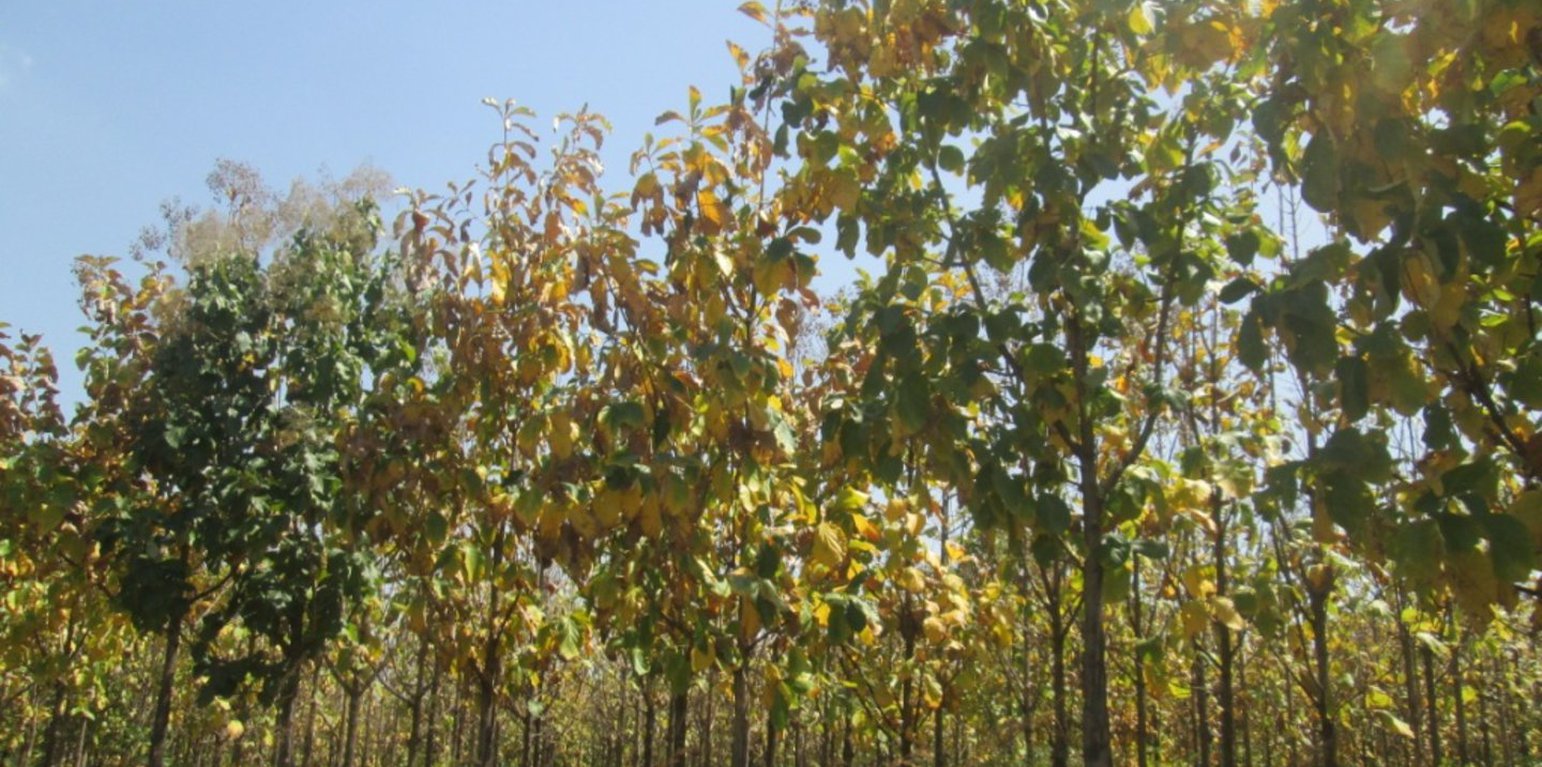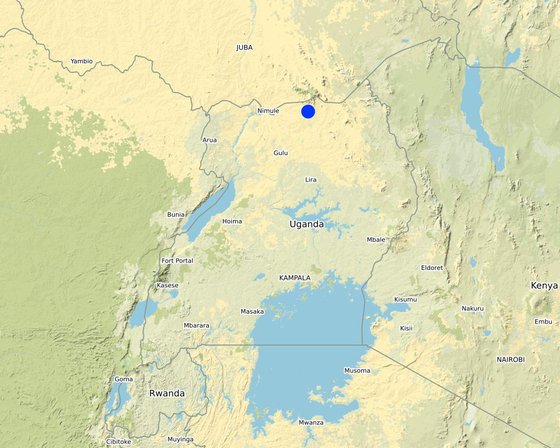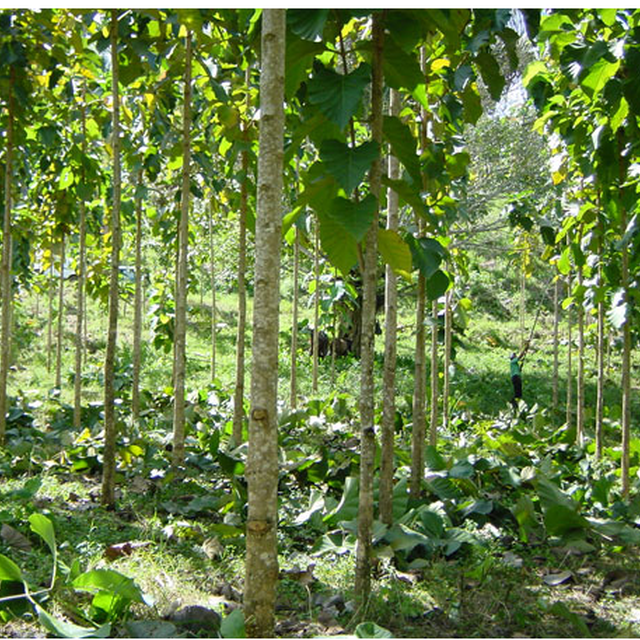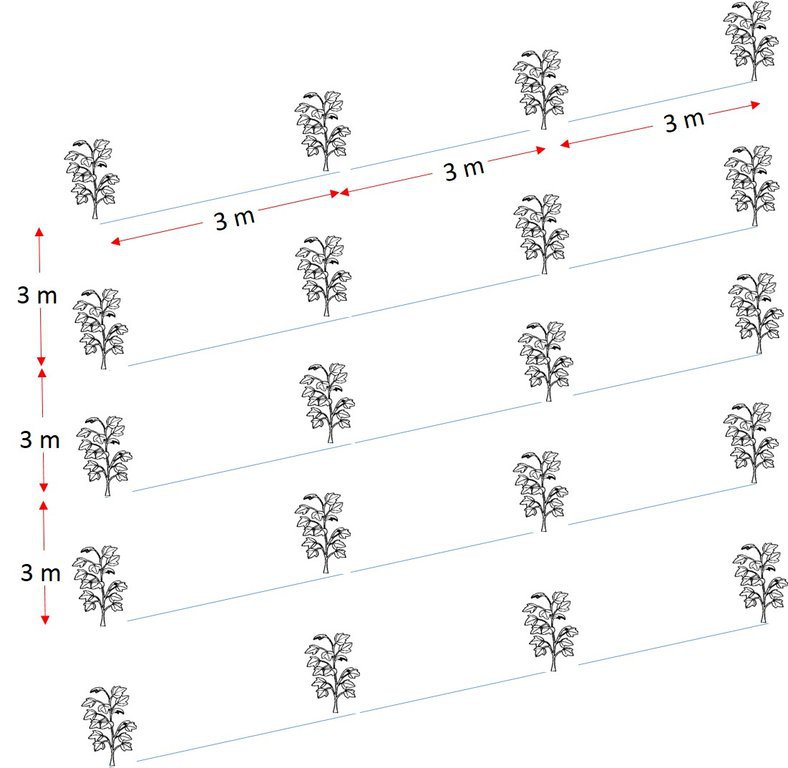



Drought-tolerant Teak (Tectona grandis) is suitable for planting in semi-arid areas. In northern Uganda, farmers are establishing plantations of Teak for timber production as opposed to other plantation species like Pines and clonal Eucalyptus.
Seeds are raised in pots, small seedling containers in which they grow into seedlings. When the rains start, usually around April, or September, the seedlings are planted out, with 1,100 seedlings planted per hectare. Teak trees are planted at a spacing of 3 x 3 meters and thinned at 5 and 9 years to retain approximately 450 trees per hectare. To ensure that the timber produced from the trees does not have knots, pruning is done to remove lower branches as the tree grows. Pruning is normally done starting at the age of 3 years. Like most tree planting projects, framers tend to plan Teak on less productive land, leaving the fertile parts of their land for food and other high-value cash crops.
The cost of establishing a Teak plantations is high in the first 2-3 years but reduces significantly after first thinning. The cost of weeding can be reduced by spot-weeding of seedlings up to age 3 years, after which slashing or spraying with herbicides (usually Round-up) is used for weed control. Wood from thinning is also sold as firewood or construction poles to recover some the establishment costs. Shading of leave by Teak is heavy during the dry season and this causes a risk of fire. Therefore, fire control is done by establishing a fine-line, an open space of 6 meters to separate the plantation into compartments in order to restrict fire from spreading from one part to another part.
Farmers like Teak because it endures dry conditions and can provide high-quality timber. Although not exploited yet, these Teak plantations can be used for carbon trade and further improve the income of the farmer. What farmers do not like about Teak is that unlike several other specie where livestock can be integrated in the plantation, it is not possible for teak because it does not support undergrowth.

地点: Padibe s/county Lamwo District, Northern, 乌干达
分析的技术场所数量: 单一场所
技术传播: 均匀地分布在一个区域 (approx. < 0.1 平方千米(10 公顷))
实施日期: 2012
介绍类型





| 对投入进行具体说明 | 单位 | 数量 | 单位成本 (Uganda Shillings) | 每项投入的总成本 (Uganda Shillings) | 土地使用者承担的成本% |
| 劳动力 | |||||
| Raising seedlings in the nursry | Mandays | 120.0 | 5000.0 | 600000.0 | 100.0 |
| Land clearing | Acre | 1.0 | 200000.0 | 200000.0 | 100.0 |
| Planting | Acre | 1.0 | 200000.0 | 200000.0 | 100.0 |
| 设备 | |||||
| Watering Cans | Number | 3.0 | 10000.0 | 30000.0 | 100.0 |
| Jerricans | Number | 5.0 | 8000.0 | 40000.0 | 100.0 |
| 植物材料 | |||||
| Seeds of Teak | kg | 1.0 | 100000.0 | 100000.0 | 100.0 |
| 施工材料 | |||||
| Poles for the nursery | Number | 30.0 | 5000.0 | 150000.0 | 100.0 |
| Grass for shading the seedlings | Bundles | 10.0 | 10000.0 | 100000.0 | 100.0 |
| 技术建立所需总成本 | 1'420'000.0 | ||||
| 对投入进行具体说明 | 单位 | 数量 | 单位成本 (Uganda Shillings) | 每项投入的总成本 (Uganda Shillings) | 土地使用者承担的成本% |
| 劳动力 | |||||
| Weeding | Acre | 1.0 | 150000.0 | 150000.0 | 100.0 |
| Pruning | Acre | 1.0 | 200000.0 | 200000.0 | 100.0 |
| Thinning | Acre | 1.0 | 200000.0 | 200000.0 | 100.0 |
| Regular patrol for fire protection | Years | 15.0 | 600000.0 | 9000000.0 | 100.0 |
| 设备 | |||||
| Hoes | Number | 5.0 | 15000.0 | 75000.0 | 100.0 |
| Pangas | Number | 5.0 | 8000.0 | 40000.0 | 100.0 |
| Pruning saws | Number | 5.0 | 20000.0 | 100000.0 | 100.0 |
| 技术维护所需总成本 | 9'765'000.0 | ||||